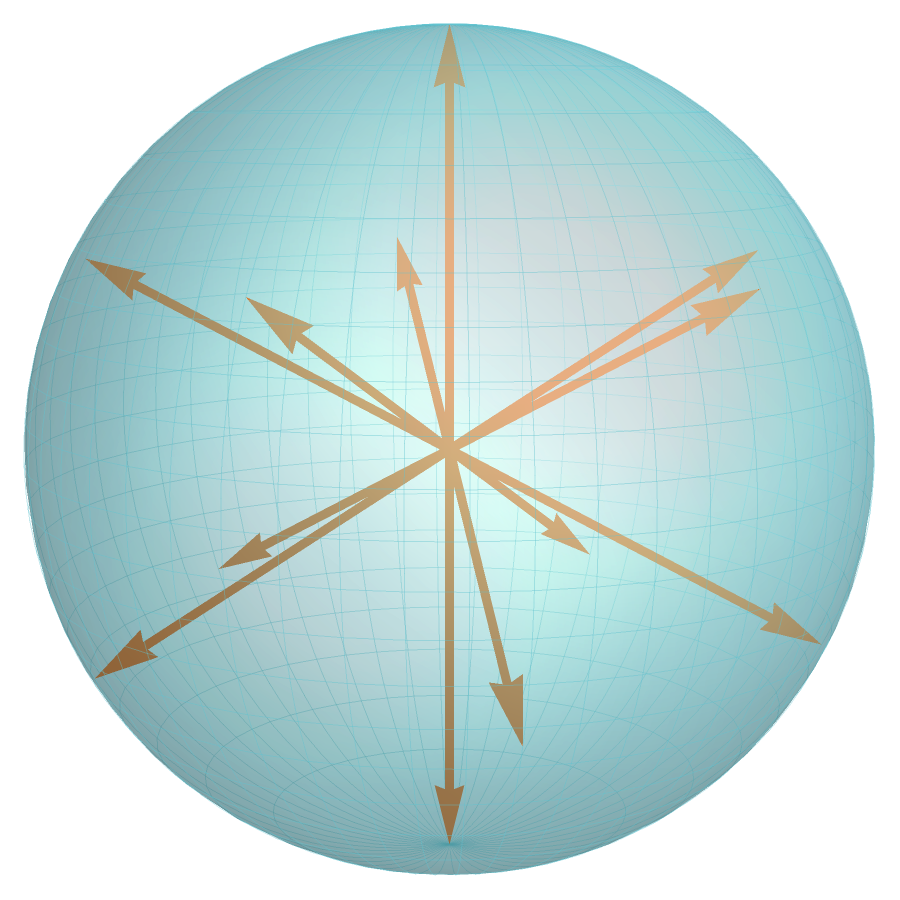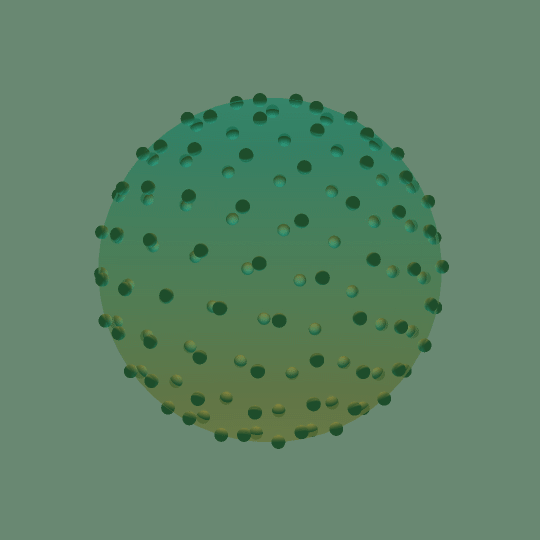Symplectic Geometry and Frame Theory
/ag19
This talk!
Take Home Message
Symplectic geometry is a powerful set of tools which is useful for the study of frames
Frames
A frame in \(\mathbb{C}^d\) is an ordered spanning set \(\{\phi_1,\dots ,\phi_N\}\), which we often represent as a short, fat matrix


Symplectic Geometry
Definition. A symplectic manifold is a smooth manifold \(M\) together with a closed, non-degenerate 2-form \({\omega \in \Omega^2(M)}\).
Example: \((S^2,d\theta\wedge dz)\)
Example. \((\mathbb{R}^2,dx \wedge dy) = (\mathbb{C},\frac{i}{2}dz \wedge d\bar{z})\)
Any smooth (affine or projective) complex variety is a symplectic manifold.
Example. \((S^2,\omega)\), where \(\omega_p(u,v) = (u \times v) \cdot p\)
Example. \((\mathbb{R}^2,\omega)\) where \(\omega(u,v) = \langle i u, v \rangle \)
Example. \((\mathbb{C}^n, \frac{i}{2} \sum dz_k \wedge d\overline{z}_k)\)
Maps
If \(H: M \to \mathbb{R}\) is smooth, then there exists a unique vector field \(X_H\) so that \({dH = \iota_{X_H}\omega}\), i.e.,
(\(X_H\) is called the Hamiltonian vector field for \(H\), or sometimes the symplectic gradient of \(H\))
Example. \(H: (S^2, d\theta\wedge dz) \to \mathbb{R}\) given by \(H(\theta,z) = z\).
\(dH = dz = \iota_{\frac{\partial}{\partial \theta}}(d\theta\wedge dz)\), so \(X_H = \frac{\partial}{\partial \theta}\).


Lie Group Actions
Let \(G\) be a Lie group, and let \(\mathfrak{g}\) be its Lie algebra. If \(G\) acts on \((M,\omega)\), then each \(V \in \mathfrak{g}\) determines a vector field \(X_V\) on \(M\) by

\(S^1=U(1)\) acts on \((S^2,d\theta \wedge dz)\) by
For \(r \in \mathbb{R} \simeq \mathfrak{u}(1)\), \(X_r = r \frac{\partial}{\partial \theta}\).
Momentum Maps
Definition. An action of \(U(1)\) on \((M,\omega)\) is Hamiltonian if there exists a map
so that \(d\mu = \iota_{X}\omega\), where \(X\) is the vector field generated by the circle action.

\(X = \frac{\partial}{\partial \theta}\)
\(\iota_X\omega = \iota_{\frac{\partial}{\partial \theta}} d\theta \wedge dz = dz \)
\(\mu(\theta,z) = z\)
Momentum Maps
Definition. An action of \(G\) on \((M,\omega)\) is Hamiltonian if each one-parameter subgroup action is Hamiltonian. Equivalently, there exists a map
so that \(\omega_p(X_V, X) = D_p \mu(X)(V)\) for each \(p \in M\), \(X \in T_pM\), and \(V \in \mathfrak{g}\).

\(X_{V_{(a,b,c)}}(x,y,z) = (a,b,c) \times (x,y,z)\)
\((\iota_{X_{V_{(a,b,c)}}}\omega)_{(x,y,z)} = a dx + b dy + c dz \)
\(\mu(x,y,z)(V_{(a,b,c)}) = (x,y,z)\cdot(a,b,c)\)
Group Actions on Frames
What compact Lie groups act nicely on \(\mathbb{C}^{d \times N}\)?
- \(U(d)\) acts on the left
- \(U(N)\) acts on the right
- \(U(1)^d\) acts on the left
- \(U(1)^N\) acts on the right
Parseval frames
\(\mu_{U(d)}^{-1}(I_d)\)
unit-norm frames
\(\mu_{U(1)^N}^{-1}\left(-\frac{1}{2},\dots , -\frac{1}{2}\right)\)
FUNTFs
The (finite) unit-norm tight frames (FUNTFs) are the level set
Let \(\mu\) be the momentum map of the product group
The Frame Homotopy Conjecture
Theorem [Cahill–Mixon–Strawn ’17]
The space of length-\(N\) FUNTFs in \(\mathbb{C}^d\) is path-connected for all \(N \geq d\geq 1\).
A New Proof
FUNTF space is connected if and only if
Theorem [Atiyah]
Torus reductions of compact, connected symplectic manifolds are connected.
is.
A Double Generalization
Theorem [with Needham]
For any invertible, Hermitian matrix \(S\) and any \(r_1, \dots , r_N \geq 0\), the space of frames \(\Phi = [\phi_1 | \cdots | \phi_N]\) with
and
is either empty or path-connected.
Symplectic Geometry and Frame Theory
This seems to be a pretty general viewpoint, with a number of potential applications...
See, for example, Tom Needham’s talk.
Thank you!
Funding: Simons Foundation
References
Symplectic geometry and connectivity of space of frames
Tom Needham and Clayton Shonkwiler
The geometry of constrained random walks and an application to frame theory
Clayton Shonkwiler
2018 IEEE Statistical Signal Processing Workshop (SSP), 343–347